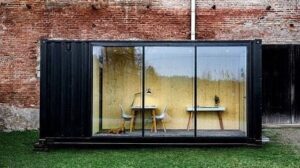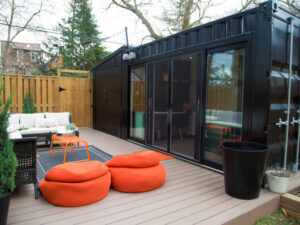Shipping containers have so many different purposes these days. People use different types of containers for their commercial needs like realtors staging houses, extra storage or even an entire modular store made from a sea can. They are also used for residential purposes when people are renovating a house or just need somewhere to store their seasonal belongings. With so many different uses, it’s important to get the right kind of sea can for your needs, size, colour, insulated or not insulated. Let’s check out the different types of shipping containers that we can offer you.
But, before we do we go over the different types of shipping containers available at Coast Containers, it is important to know what you can fit into a 10ft, 20ft, or 40ft storage container. Below we have put together what a typical size storage container fits in terms of the contents of an apartment or house.
What Can Fit in a 10ft, 20ft and 40ft Container?
10ft Containers
10ft sea cans are a type of shipping container that works best for people who need storage but have limited space on their property. This size is large enough to be able to hold the contents of a studio or small one-bedroom apartment. Clear out your garage, storage room or workshop by storing these items right on your property for easy access. A 10ft sea can is also ideal for holding furniture and household items during a home renovation or staging.
Renovating room to room? A 10ft sea can is great for storing one room at a time while you work on different areas of your home.
Is your house going on the market soon? Storing your extra personal items or furniture in order to stage your home can increase the value and appeal of your home to buyers.
20ft Containers
20ft sea cans are an industry favourite due to their size and versatility, providing our customers with endless possibilities for storage and modifications. Owning this shipping container type is great for keeping on your property as an extra storage space. A 20ft sea can is large enough to fit the contents of a one-to-two bedroom apartment.
Think about using a sea can for seasonal storage, storing extra furniture and household items, and converting it into a workshop or yard equipment shed. Whether you need a sea can for storage or you want to modify it into a unique space, a container will keep your thing safe for years to come!
40ft Containers
The largest full-size cargo box we offer is a 40ft sea can that can hold the contents of a two-three house with a living room, dining room, den and kitchen.
Modifying your 40ft sea can to have double doors at each end will provide you with a quick loading and unloading process. A spacious 40ft container can be used in many different ways such as:
- Storage for your recreational vehicles and collector cars during the winter.
- Storage for your yard equipment, tools and supplies.
- Construction site storage for expensive machinery, tools, equipment and supplies.
- Furniture and household items during a home remodel.
- And so much more!
Now that we have a general idea of what can fit into each container, let’s look at the different types of ocean containers.
Different Types of Shipping Containers
Dry Containers
To start off this list of different types of cargo containers, we will start with dry containers. Dry containers, also known as general purpose sea cans, are the most common container type and are used for most cargo shipping of goods that don’t need to be temperature controlled. Dry storage containers are fully enclosed sea cans that help protect goods from all the weather elements. Dry storage containers are also versatile in that they can have additional adaptations added to them based on the customer’s needs. Dry storage containers are our most popular type of container for container sales and container rentals.
Dry storage containers come in 10ft, 20ft, and 40ft, with our most popular being the 20ft and 40ft containers.
Insulated and Thermal Containers
Insulated and thermal containers are used to transport goods that need to stay at a regulated temperature like foods, pharmaceuticals and chemicals. They are fitted with temperature controls that allow the contents to stay at the desired temperature while being transported. This is an additional adaptation that can be added to a dry storage container to make it insulated. Protecting your goods from extreme weather fluctuations is ideal in places that undergo major changes in temperature.
Insulated containers can also be modified into temporary or permanent portable office spaces and tiny homes.
Flat Rack Containers
Flat Rack storage containers come in 20ft and 40ft and have collapsible sides that can be folded down to make a flat rack. These sea cans are designed for shipping oversized, heavy cargo that may not fit inside, such as vehicles and machinery with up to 45 metric tons of cargo weight capacity.
Double Door Containers or Tunnel Containers
Double door containers, also known as tunnel containers, have doors on both sides, making it quick and easy to load and unload cargo. If you are storing heavy items in a 20ft or 40ft sea can, installing an extra door a the opposite end will make your life easier when trying to maneuver heavy objects to the back of the container. Both doors are weather-tight sealed, protecting goods from the elements. Double door containers come in 20ft and 40ft sizes and are made of iron and steel, keeping everything secure.
Open Side Containers
Open side containers have the same benefits as a general-purpose sea can with the only difference being that the doors can open from all sides. This helps with storing larger items that don’t fit through the end side doors. This feature also makes it easier to load and unload the contents of the container. Open side sea cans are available in 20ft and 40ft.
Half-Height Containers
Half-height shipping containers are designed with a low centre of gravity so they can hold heavy loads. Because of the way they are designed, half-height shipping containers are often used for transporting heavy items such as stones and coal making them an ideal option for the mining industry.
High Cube Containers
High cube containers are the same as dry shipping containers, except that they are about 1 ft taller. High cube shipping containers are used for items that need just a little bit more room to fit into the container. These containers generally come in 40ft and sometimes 45ft.
Open-Top Containers
Open-top shipping containers are for specialized purposes as they have a convertible top that can be removed. Open-top sea cans are suitable for storing heavy machinery or cargo that is too tall to fit through the doors or needs to be lifted in by a crane. Open top containers have lashing rings installed inside to secure cargo.
Refrigerated ISO Containers
Refrigerated ISO container’s main purpose is transporting or storing temperature-sensitive, perishable foods. Most refrigerated sea cans rely on external power sources to maintain the container’s internal temperature. Temperatures usually range from -28°C to 21°C.
Refrigerated sea cans can provide foodbanks with additional storage for perishable food items, transportation and storage of medical supplies and pharmaceuticals, wine storage for vineyards and more.
Tank Containers
Tank containers are cargo containers with cylindrical vessels inside a 20ft ISO standard frame. Tank containers are mainly manufactured from steel and are anti-corrosive, making them great for travelling long distances. The main purpose of a tank container is to transport or store hazardous or non-hazardous liquid materials. These liquid materials include wine, oils, food, chemicals, fuels, gases and toxic substances.
Swap Body Containers
Swap body containers are a type of freight container that is interchangeable for road and rail transportation. Swap body containers also come with a convertible top, similar to an open-top sea can. The size of a swap body container is standardized and can not be stacked. A typical characteristic to indicate it is a swap body container is its folding legs underneath.
Swap body containers are most popular for transporting goods on railways and roads. However, a few disadvantages come with purchasing a sway body container. These containers are not stackable, making them not great for overseas travel. If your main purpose for purchasing a sea can is to ship items across the ocean, we would not recommend a swap body container.
Car Carrier Containers
This type of container is designed to transport cars overseas or for long distances. Car carriers generally come with collapsible racks and hooks that secure your cars in place during transportation. These sea cans are customizable and allow you to store/transport multiple cars with the proper car lifts.
Conclusion
Now that we have gone through the different shipping containers types that the shipping industry can offer, you can make a more informed decision about the different shipping container types and the size of the shipping container type you are interested in.
Coast Containers offers many different new and used shipping containers and are able to modify containers to fit the needs of our customers. Still not totally sure about the exact shipping container you need? Don’t worry, we are happy to help. Contact one of our sales representatives today for more information and to get a quote on a new or used sea can.














